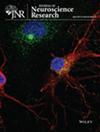A Novel Mutation in CNTNAP1 Gene Causes Disorganization of Axonal Domains, Hypomyelination and Severe Neurological Deficits
Abstract
CNTNAP1 encodes the contactin-associated protein 1 (Cntnap1) which localizes to the paranodal region in all myelinated axons and is essential for axonal domain organization and the propagation of action potentials. To date, close to 45 reported human CNTNAP1 variants have been identified that are associated with dysregulation and disorganization of the axonal domains, resulting in various forms of congenital hypomyelinating neuropathies in children. Currently, no treatments are available for neuropathies caused by CNTNAP1 variants, highlighting the importance of fully characterizing these mutations and their impact on Cntnap1 functions. To understand the importance of a novel human CNTNAP1 likely pathogenic variant that changes glycine at position 349 to valine in a child who also carries a CNTNAP1 truncation and displayed severe neurological deficits, we used CRISPR/Cas9 methodology and introduced a single nucleotide substitution in the mouse Cntnap1 gene, resulting in glycine at 350 to valine (Cntnap1G350V). Trans-allelic combination of Cntnap1G350V with a Cntnap1 null allele (Cntnap1G350V/−) mimics human pathologies, recapitulating hypomyelination neuropathies associated with CNTNAP1 mutations as well as loss of paranodal junctions and disorganization of axonal domains in myelinated axons. Expression of the wild type Cntnap1 transgene in Cntnap1G350V/− mice rescued the mutant phenotypes and restored all neurological deficits. Our studies demonstrate that GGT (glycine) to GTT (valine) change in human CNTNAP1 creates a recessive loss of function allele and lays the foundation for potential gene therapy studies aimed at treating CNTNAP1-associated hypomyelinating neuropathies in children.


 求助内容:
求助内容: 应助结果提醒方式:
应助结果提醒方式:


